service indicator CHRYSLER VOYAGER 2022 User Guide
[x] Cancel search | Manufacturer: CHRYSLER, Model Year: 2022, Model line: VOYAGER, Model: CHRYSLER VOYAGER 2022Pages: 316, PDF Size: 17.41 MB
Page 117 of 316
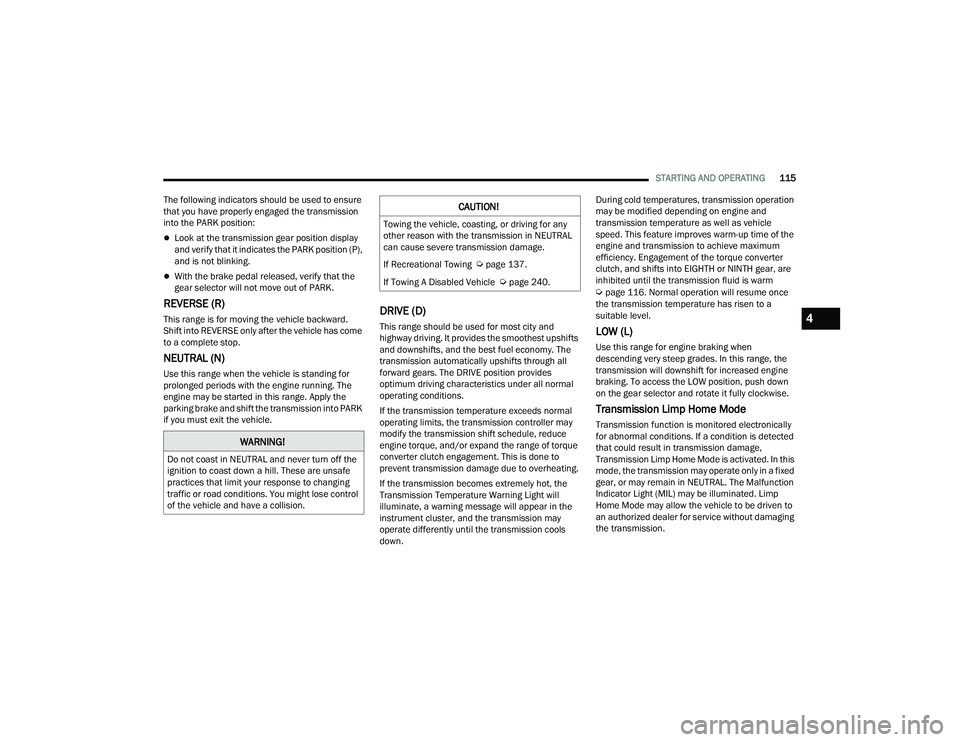
STARTING AND OPERATING115
The following indicators should be used to ensure
that you have properly engaged the transmission
into the PARK position:
Look at the transmission gear position display
and verify that it indicates the PARK position (P),
and is not blinking.
With the brake pedal released, verify that the
gear selector will not move out of PARK.
REVERSE (R)
This range is for moving the vehicle backward.
Shift into REVERSE only after the vehicle has come
to a complete stop.
NEUTRAL (N)
Use this range when the vehicle is standing for
prolonged periods with the engine running. The
engine may be started in this range. Apply the
parking brake and shift the transmission into PARK
if you must exit the vehicle.
DRIVE (D)
This range should be used for most city and
highway driving. It provides the smoothest upshifts
and downshifts, and the best fuel economy. The
transmission automatically upshifts through all
forward gears. The DRIVE position provides
optimum driving characteristics under all normal
operating conditions.
If the transmission temperature exceeds normal
operating limits, the transmission controller may
modify the transmission shift schedule, reduce
engine torque, and/or expand the range of torque
converter clutch engagement. This is done to
prevent transmission damage due to overheating.
If the transmission becomes extremely hot, the
Transmission Temperature Warning Light will
illuminate, a warning message will appear in the
instrument cluster, and the transmission may
operate differently until the transmission cools
down. During cold temperatures, transmission operation
may be modified depending on engine and
transmission temperature as well as vehicle
speed. This feature improves warm-up time of the
engine and transmission to achieve maximum
efficiency. Engagement of the torque converter
clutch, and shifts into EIGHTH or NINTH gear, are
inhibited until the transmission fluid is warm
Úpage 116. Normal operation will resume once
the transmission temperature has risen to a
suitable level.
LOW (L)
Use this range for engine braking when
descending very steep grades. In this range, the
transmission will downshift for increased engine
braking. To access the LOW position, push down
on the gear selector and rotate it fully clockwise.
Transmission Limp Home Mode
Transmission function is monitored electronically
for abnormal conditions. If a condition is detected
that could result in transmission damage,
Transmission Limp Home Mode is activated. In this
mode, the transmission may operate only in a fixed
gear, or may remain in NEUTRAL. The Malfunction
Indicator Light (MIL) may be illuminated. Limp
Home Mode may allow the vehicle to be driven to
an authorized dealer for service without damaging
the transmission.
WARNING!
Do not coast in NEUTRAL and never turn off the
ignition to coast down a hill. These are unsafe
practices that limit your response to changing
traffic or road conditions. You might lose control
of the vehicle and have a collision.
CAUTION!
Towing the vehicle, coasting, or driving for any
other reason with the transmission in NEUTRAL
can cause severe transmission damage.
If Recreational Towing
Úpage 137.
If Towing A Disabled Vehicle
Úpage 240.
4
22_RUVG_OM_EN_USC_t.book Page 115
Page 121 of 316
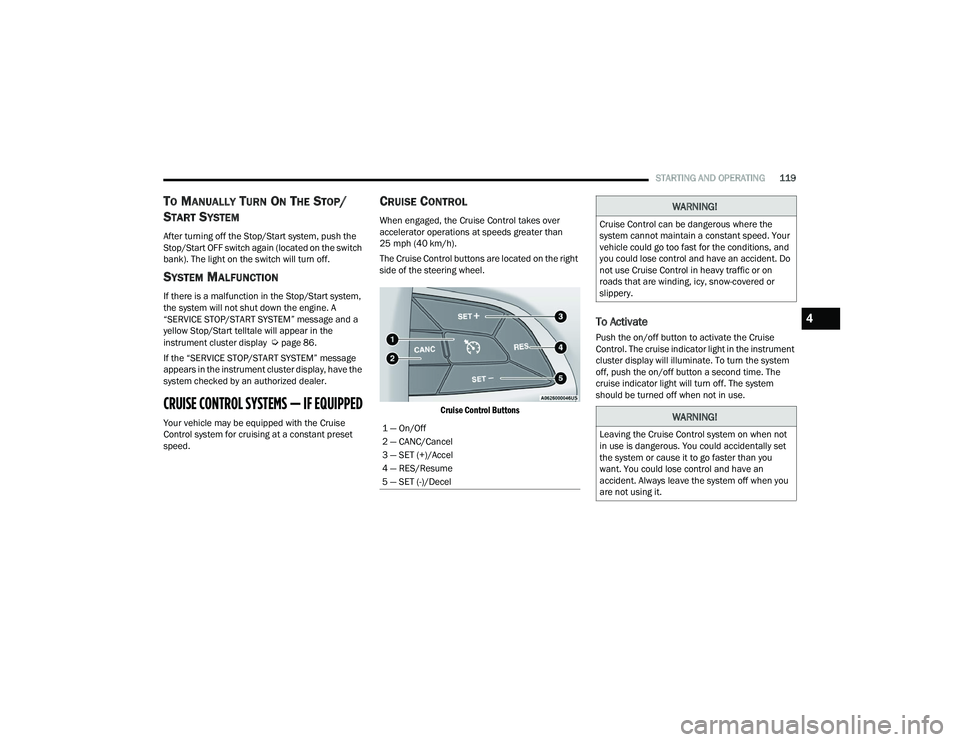
STARTING AND OPERATING119
TO MANUALLY TURN ON THE STOP/
S
TART SYSTEM
After turning off the Stop/Start system, push the
Stop/Start OFF switch again (located on the switch
bank). The light on the switch will turn off.
SYSTEM MALFUNCTION
If there is a malfunction in the Stop/Start system,
the system will not shut down the engine. A
“SERVICE STOP/START SYSTEM” message and a
yellow Stop/Start telltale will appear in the
instrument cluster display
Úpage 86.
If the “SERVICE STOP/START SYSTEM” message
appears in the instrument cluster display, have the
system checked by an authorized dealer.
CRUISE CONTROL SYSTEMS — IF EQUIPPED
Your vehicle may be equipped with the Cruise
Control system for cruising at a constant preset
speed.
CRUISE CONTROL
When engaged, the Cruise Control takes over
accelerator operations at speeds greater than
25 mph (40 km/h).
The Cruise Control buttons are located on the right
side of the steering wheel.
Cruise Control Buttons
To Activate
Push the on/off button to activate the Cruise
Control. The cruise indicator light in the instrument
cluster display will illuminate. To turn the system
off, push the on/off button a second time. The
cruise indicator light will turn off. The system
should be turned off when not in use.
1 — On/Off
2 — CANC/Cancel
3 — SET (+)/Accel
4 — RES/Resume
5 — SET (-)/Decel
WARNING!
Cruise Control can be dangerous where the
system cannot maintain a constant speed. Your
vehicle could go too fast for the conditions, and
you could lose control and have an accident. Do
not use Cruise Control in heavy traffic or on
roads that are winding, icy, snow-covered or
slippery.
WARNING!
Leaving the Cruise Control system on when not
in use is dangerous. You could accidentally set
the system or cause it to go faster than you
want. You could lose control and have an
accident. Always leave the system off when you
are not using it.
4
22_RUVG_OM_EN_USC_t.book Page 119
Page 239 of 316
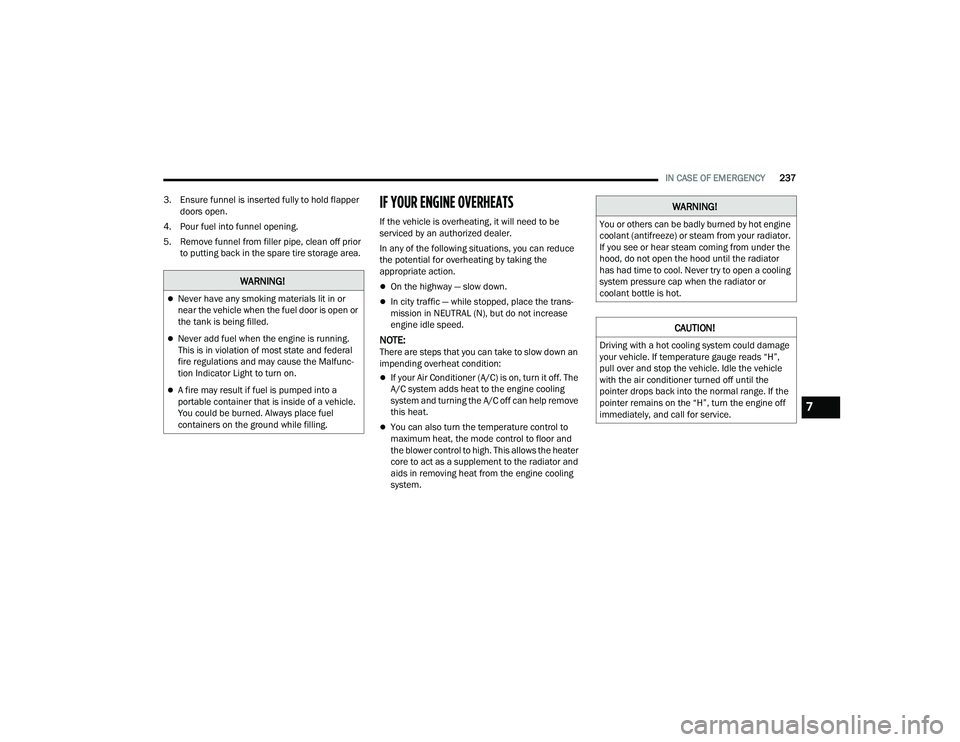
IN CASE OF EMERGENCY237
3. Ensure funnel is inserted fully to hold flapper doors open.
4. Pour fuel into funnel opening.
5. Remove funnel from filler pipe, clean off prior to putting back in the spare tire storage area.
IF YOUR ENGINE OVERHEATS
If the vehicle is overheating, it will need to be
serviced by an authorized dealer.
In any of the following situations, you can reduce
the potential for overheating by taking the
appropriate action.
On the highway — slow down.
In city traffic — while stopped, place the trans -
mission in NEUTRAL (N), but do not increase
engine idle speed.
NOTE:There are steps that you can take to slow down an
impending overheat condition:
If your Air Conditioner (A/C) is on, turn it off. The
A/C system adds heat to the engine cooling
system and turning the A/C off can help remove
this heat.
You can also turn the temperature control to
maximum heat, the mode control to floor and
the blower control to high. This allows the heater
core to act as a supplement to the radiator and
aids in removing heat from the engine cooling
system.
WARNING!
Never have any smoking materials lit in or
near the vehicle when the fuel door is open or
the tank is being filled.
Never add fuel when the engine is running.
This is in violation of most state and federal
fire regulations and may cause the Malfunc -
tion Indicator Light to turn on.
A fire may result if fuel is pumped into a
portable container that is inside of a vehicle.
You could be burned. Always place fuel
containers on the ground while filling.
WARNING!
You or others can be badly burned by hot engine
coolant (antifreeze) or steam from your radiator.
If you see or hear steam coming from under the
hood, do not open the hood until the radiator
has had time to cool. Never try to open a cooling
system pressure cap when the radiator or
coolant bottle is hot.
CAUTION!
Driving with a hot cooling system could damage
your vehicle. If temperature gauge reads “H”,
pull over and stop the vehicle. Idle the vehicle
with the air conditioner turned off until the
pointer drops back into the normal range. If the
pointer remains on the “H”, turn the engine off
immediately, and call for service.
7
22_RUVG_OM_EN_USC_t.book Page 237
Page 245 of 316
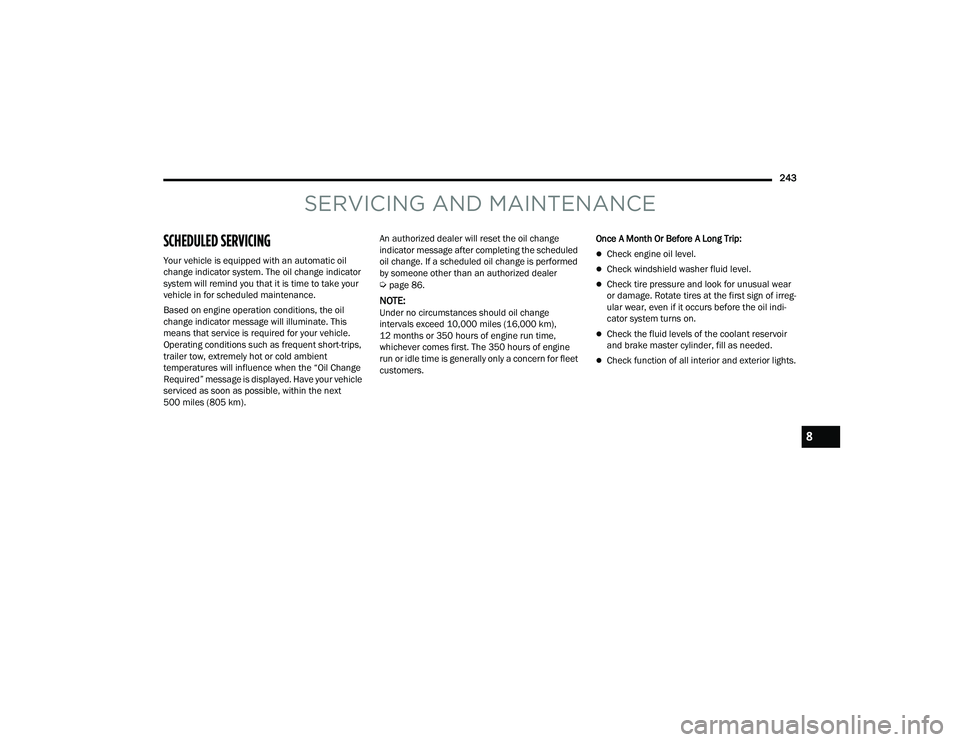
243
SERVICING AND MAINTENANCE
SCHEDULED SERVICING
Your vehicle is equipped with an automatic oil
change indicator system. The oil change indicator
system will remind you that it is time to take your
vehicle in for scheduled maintenance.
Based on engine operation conditions, the oil
change indicator message will illuminate. This
means that service is required for your vehicle.
Operating conditions such as frequent short-trips,
trailer tow, extremely hot or cold ambient
temperatures will influence when the “Oil Change
Required” message is displayed. Have your vehicle
serviced as soon as possible, within the next
500 miles (805 km).An authorized dealer will reset the oil change
indicator message after completing the scheduled
oil change. If a scheduled oil change is performed
by someone other than an authorized dealer
Úpage 86.
NOTE:Under no circumstances should oil change
intervals exceed 10,000 miles (16,000 km),
12 months or 350 hours of engine run time,
whichever comes first. The 350 hours of engine
run or idle time is generally only a concern for fleet
customers.
Once A Month Or Before A Long Trip:
Check engine oil level.
Check windshield washer fluid level.
Check tire pressure and look for unusual wear
or damage. Rotate tires at the first sign of irreg
-
ular wear, even if it occurs before the oil indi -
cator system turns on.
Check the fluid levels of the coolant reservoir
and brake master cylinder, fill as needed.
Check function of all interior and exterior lights.
8
22_RUVG_OM_EN_USC_t.book Page 243
Page 286 of 316

284SERVICING AND MAINTENANCE
Consult an authorized tire dealer for tire repairs
and additional information.
Damaged Run Flat tires, or Run Flat tires that have
experienced a loss of pressure should be replaced
immediately with another Run Flat tire of identical
size and service description (Load Index and
Speed Symbol). Replace the tire pressure sensor
as well as it is not designed to be reused.
Run Flat Tires — If Equipped
Run Flat tires allow you the capability to drive
50 miles (80 km) at 50 mph (80 km/h) after a
rapid loss of inflation pressure. This rapid loss of
inflation is referred to as the Run Flat mode. A Run
Flat mode occurs when the tire inflation pressure is
of/or below 14 psi (96 kPa). Once a Run Flat tire
reaches the Run Flat mode it has limited driving
capabilities and needs to be replaced immediately.
A Run Flat tire is not repairable. When a Run Flat
tire is changed after driving with underinflated tire
condition, please replace the TPM sensor as it is
not designed to be reused when driven under run
flat mode 14 psi (96 kPa) condition.
NOTE:TPM Sensor must be replaced after driving the
vehicle on a flat tire condition. It is not recommended driving a vehicle loaded at
full capacity or to tow a trailer while a tire is in the
run flat mode
Úpage 171.
Tire Spinning
When stuck in mud, sand, snow, or ice conditions,
do not spin your vehicle's wheels above 30 mph
(48 km/h) or for longer than 30 seconds
continuously without stopping.
Tread Wear Indicators
Tread wear indicators are in the original equipment
tires to help you in determining when your tires
should be replaced.
Tire Tread
These indicators are molded into the bottom of the
tread grooves. They will appear as bands when the
tread depth becomes a 1/16 of an inch (1.6 mm).
When the tread is worn to the tread wear
indicators, the tire should be replaced
Úpage 285.
WARNING!
Fast spinning tires can be dangerous. Forces
generated by excessive wheel speeds may
cause tire damage or failure. A tire could
explode and injure someone. Do not spin your
vehicle's wheels faster than 30 mph (48 km/h)
for more than 30 seconds continuously when
you are stuck, and do not let anyone near a
spinning wheel, no matter what the speed.1 — Worn Tire
2 — New Tire
22_RUVG_OM_EN_USC_t.book Page 284
Page 308 of 316
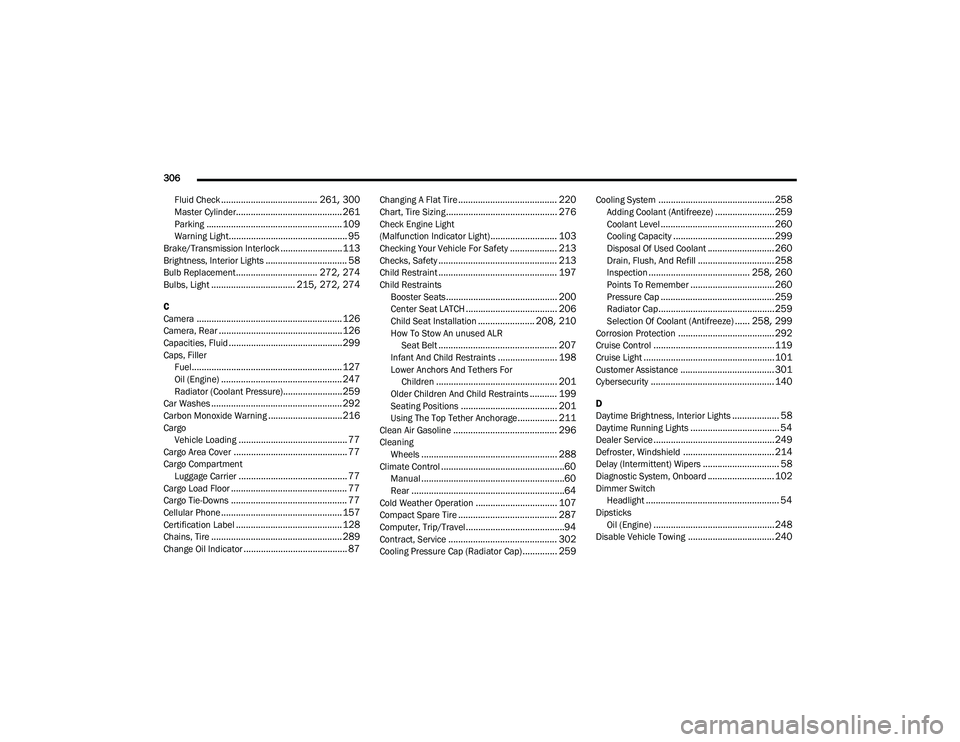
306
Fluid Check
....................................... 261, 300Master Cylinder........................................... 261Parking....................................................... 109Warning Light................................................ 95Brake/Transmission Interlock.........................113Brightness, Interior Lights................................. 58Bulb Replacement................................. 272, 274Bulbs, Light.................................. 215, 272, 274
C
Camera........................................................... 126Camera, Rear..................................................126Capacities, Fluid..............................................299Caps, Filler Fuel.............................................................127Oil (Engine)................................................. 247Radiator (Coolant Pressure)........................259Car Washes..................................................... 292Carbon Monoxide Warning..............................216CargoVehicle Loading
............................................ 77Cargo Area Cover.............................................. 77Cargo CompartmentLuggage Carrier............................................ 77Cargo Load Floor............................................... 77Cargo Tie-Downs............................................... 77Cellular Phone................................................. 157Certification Label........................................... 128Chains, Tire..................................................... 289Change Oil Indicator.......................................... 87
Changing A Flat Tire........................................ 220Chart, Tire Sizing............................................. 276Check Engine Light
(Malfunction Indicator Light)........................... 103Checking Your Vehicle For Safety................... 213Checks, Safety................................................ 213Child Restraint................................................ 197Child RestraintsBooster Seats............................................. 200Center Seat LATCH..................................... 206Child Seat Installation....................... 208, 210How To Stow An unused ALR Seat Belt................................................ 207Infant And Child Restraints........................ 198Lower Anchors And Tethers For Children................................................. 201Older Children And Child Restraints........... 199Seating Positions....................................... 201Using The Top Tether Anchorage................ 211Clean Air Gasoline.......................................... 296CleaningWheels....................................................... 288Climate Control..................................................60Manual..........................................................60Rear..............................................................64Cold Weather Operation................................. 107Compact Spare Tire........................................ 287Computer, Trip/Travel........................................94Contract, Service............................................ 302Cooling Pressure Cap (Radiator Cap).............. 259
Cooling System...............................................258Adding Coolant (Antifreeze)........................259Coolant Level.............................................. 260Cooling Capacity.........................................299Disposal Of Used Coolant........................... 260Drain, Flush, And Refill............................... 258Inspection......................................... 258, 260Points To Remember..................................260Pressure Cap.............................................. 259Radiator Cap...............................................259Selection Of Coolant (Antifreeze)...... 258, 299Corrosion Protection.......................................292Cruise Control.................................................119Cruise Light.....................................................101Customer Assistance...................................... 301Cybersecurity.................................................. 140
D
Daytime Brightness, Interior Lights................... 58Daytime Running Lights.................................... 54
Dealer Service.................................................249Defroster, Windshield.....................................214Delay (Intermittent) Wipers............................... 58Diagnostic System, Onboard........................... 102Dimmer SwitchHeadlight...................................................... 54DipsticksOil (Engine).................................................248Disable Vehicle Towing...................................240
22_RUVG_OM_EN_USC_t.book Page 306
Page 311 of 316
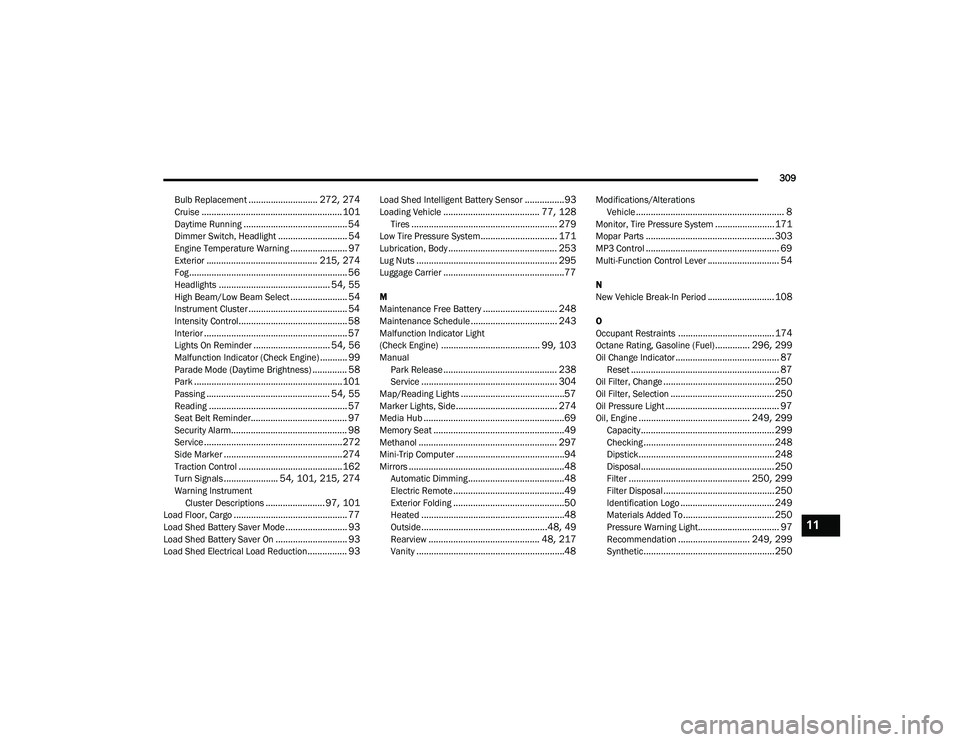
309
Bulb Replacement
............................ 272, 274Cruise......................................................... 101Daytime Running.......................................... 54Dimmer Switch, Headlight............................ 54Engine Temperature Warning....................... 97Exterior............................................. 215, 274Fog................................................................ 56Headlights............................................. 54, 55High Beam/Low Beam Select....................... 54Instrument Cluster........................................ 54Intensity Control............................................ 58Interior.......................................................... 57Lights On Reminder............................... 54, 56Malfunction Indicator (Check Engine)........... 99Parade Mode (Daytime Brightness).............. 58Park............................................................101Passing.................................................. 54, 55Reading........................................................ 57Seat Belt Reminder....................................... 97Security Alarm............................................... 98Service........................................................272Side Marker................................................274Traction Control..........................................162Turn Signals...................... 54, 101, 215, 274Warning Instrument Cluster Descriptions........................ 97, 101Load Floor, Cargo.............................................. 77Load Shed Battery Saver Mode......................... 93Load Shed Battery Saver On............................. 93Load Shed Electrical Load Reduction................ 93
Load Shed Intelligent Battery Sensor................93Loading Vehicle....................................... 77, 128Tires........................................................... 279Low Tire Pressure System............................... 171Lubrication, Body............................................ 253Lug Nuts......................................................... 295Luggage Carrier.................................................77
M
Maintenance Free Battery.............................. 248Maintenance Schedule................................... 243Malfunction Indicator Light
(Check Engine)........................................ 99, 103ManualPark Release.............................................. 238Service....................................................... 304Map/Reading Lights..........................................57Marker Lights, Side......................................... 274Media Hub.........................................................69Memory Seat.....................................................49Methanol........................................................ 297Mini-Trip Computer............................................94Mirrors...............................................................48Automatic Dimming.......................................48Electric Remote.............................................49Exterior Folding.............................................50Heated..........................................................48Outside...................................................48, 49Rearview............................................. 48, 217Vanity............................................................48
Modifications/AlterationsVehicle............................................................ 8Monitor, Tire Pressure System........................171Mopar Parts.................................................... 303MP3 Control...................................................... 69Multi-Function Control Lever............................. 54
N
New Vehicle Break-In Period........................... 108
O
Occupant Restraints.......................................174Octane Rating, Gasoline (Fuel).............. 296, 299Oil Change Indicator.......................................... 87Reset............................................................ 87Oil Filter, Change.............................................250Oil Filter, Selection.......................................... 250Oil Pressure Light.............................................. 97Oil, Engine............................................. 249, 299Capacity...................................................... 299Checking.....................................................248Dipstick.......................................................248Disposal...................................................... 250Filter................................................. 250, 299Filter Disposal.............................................250Identification Logo...................................... 249Materials Added To.....................................250Pressure Warning Light................................. 97Recommendation............................. 249, 299Synthetic.....................................................250
11
22_RUVG_OM_EN_USC_t.book Page 309